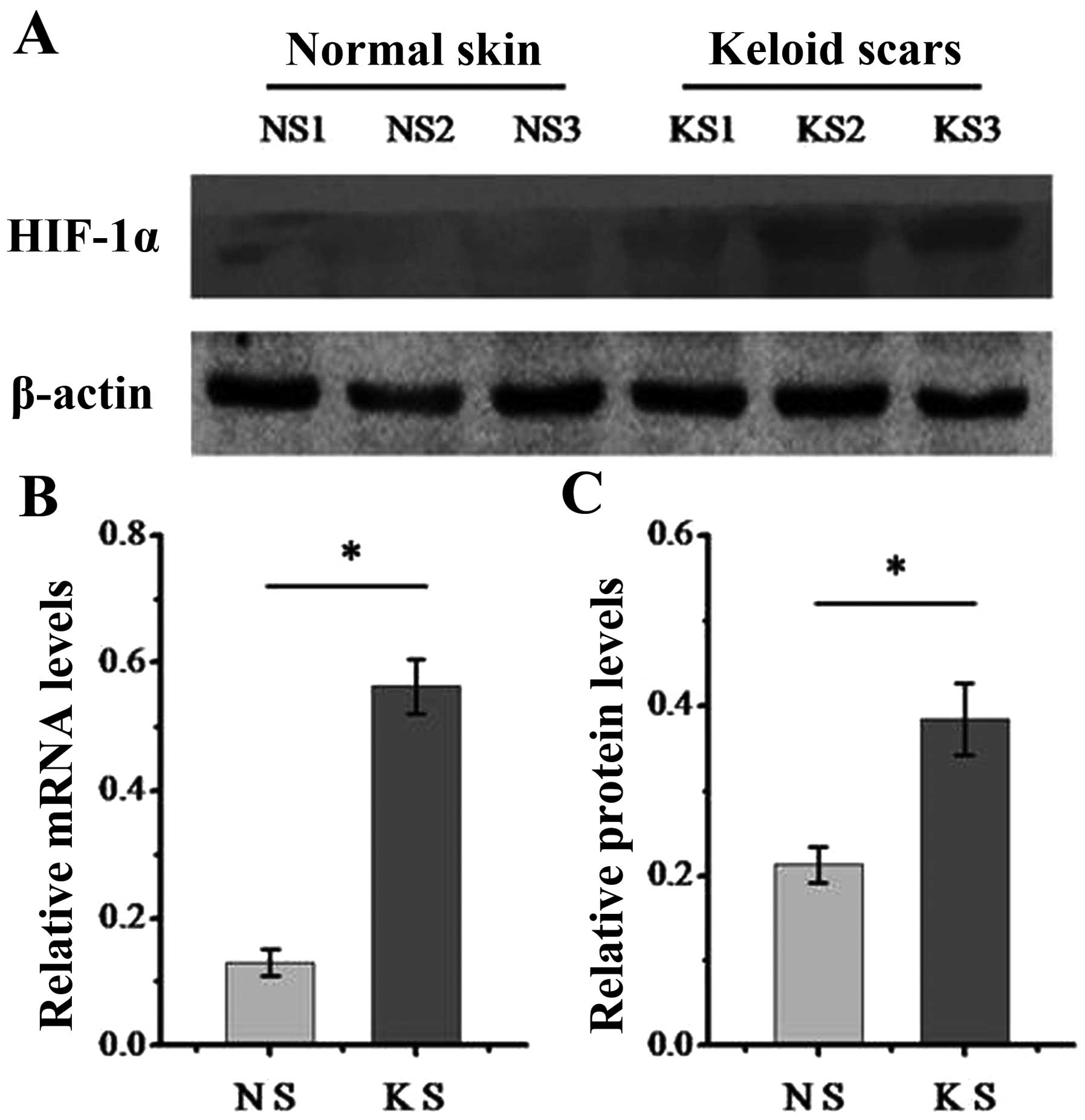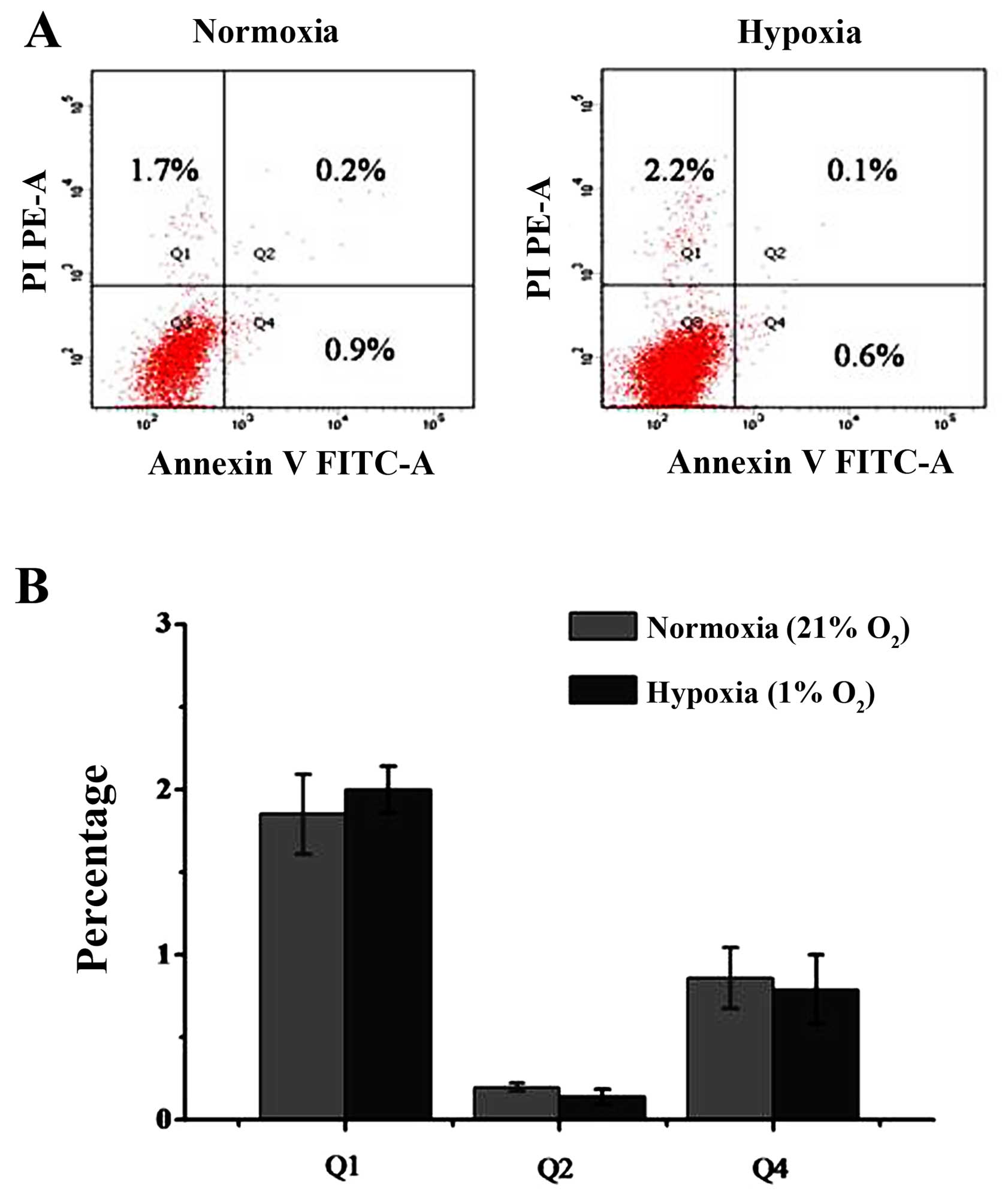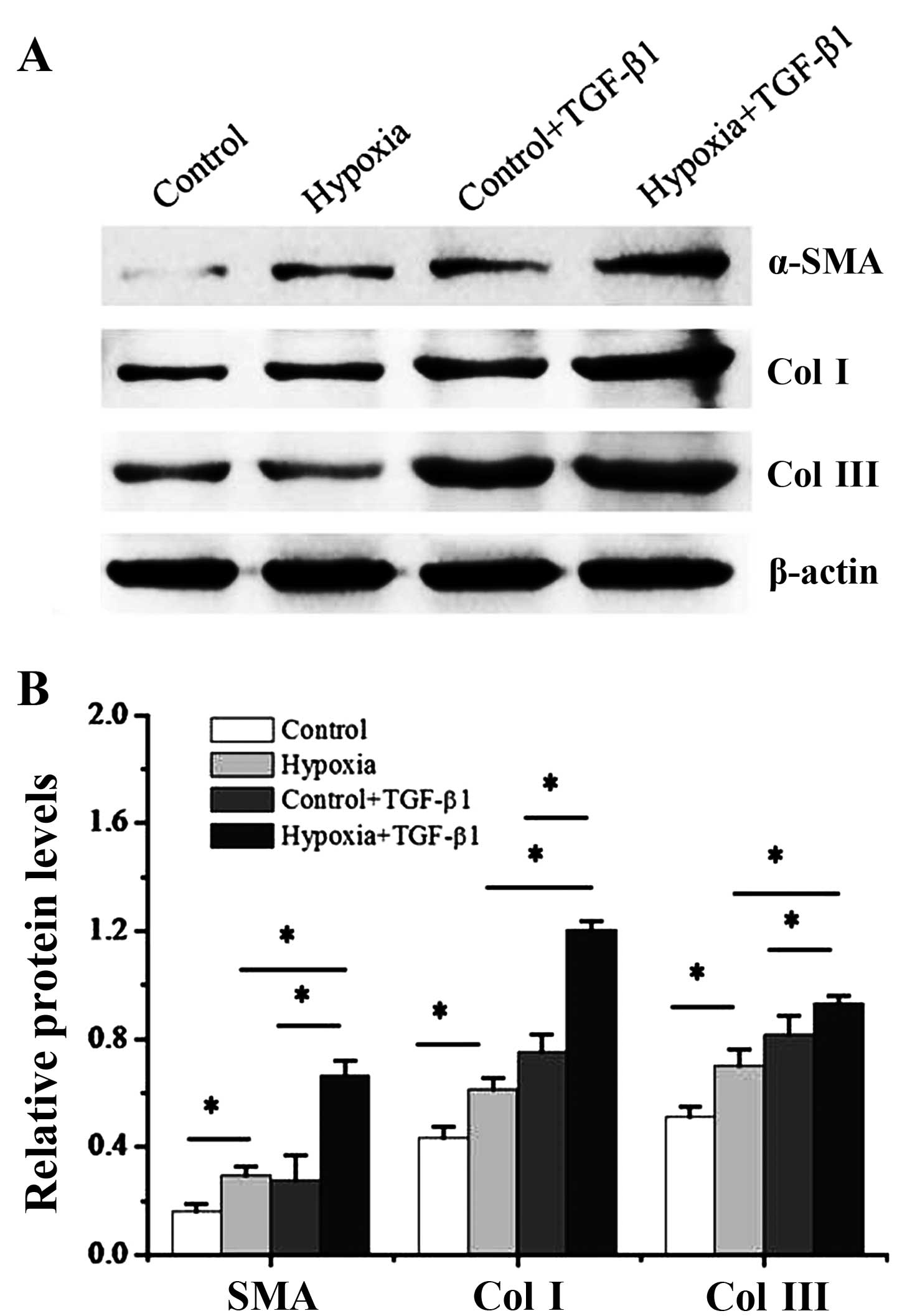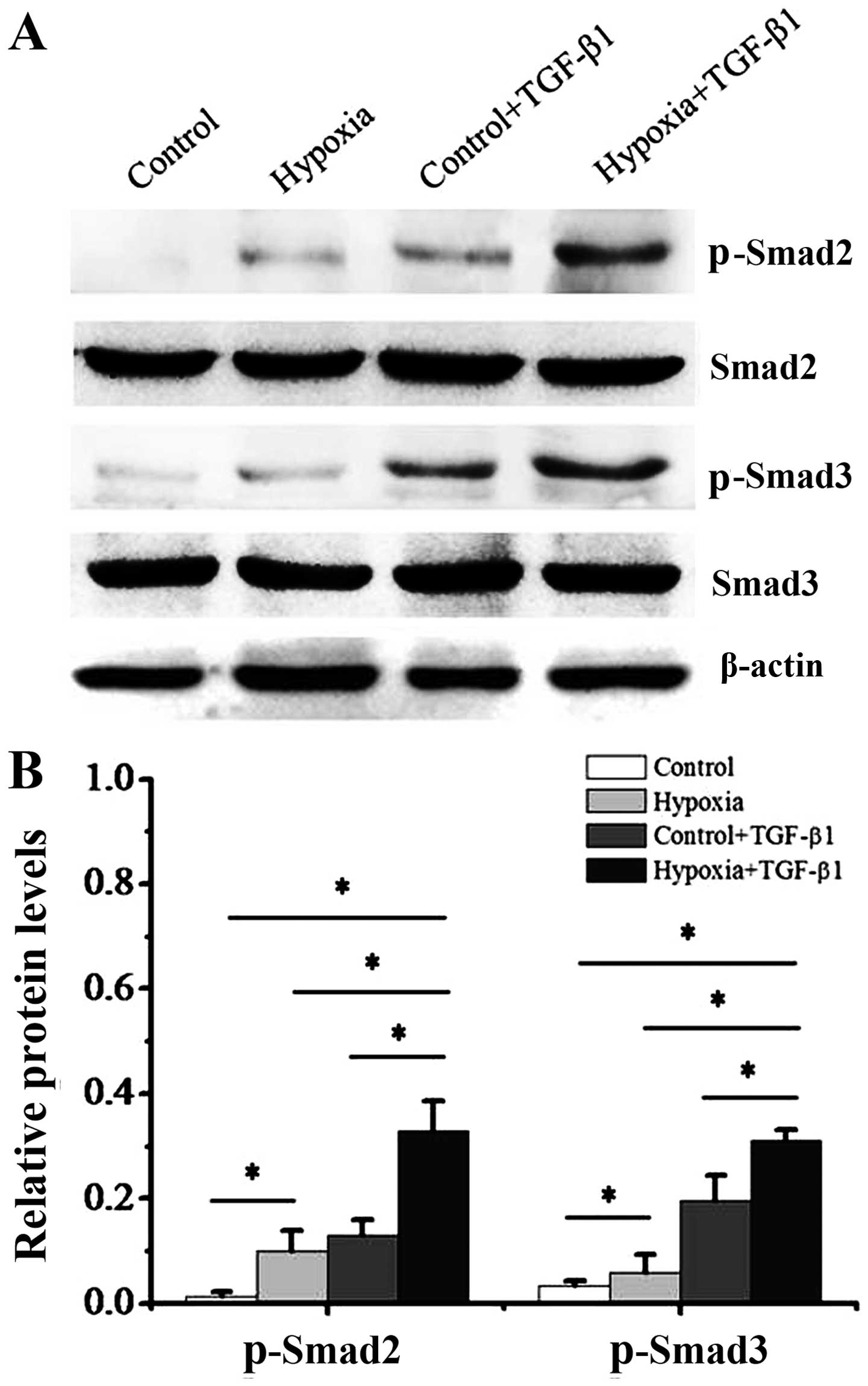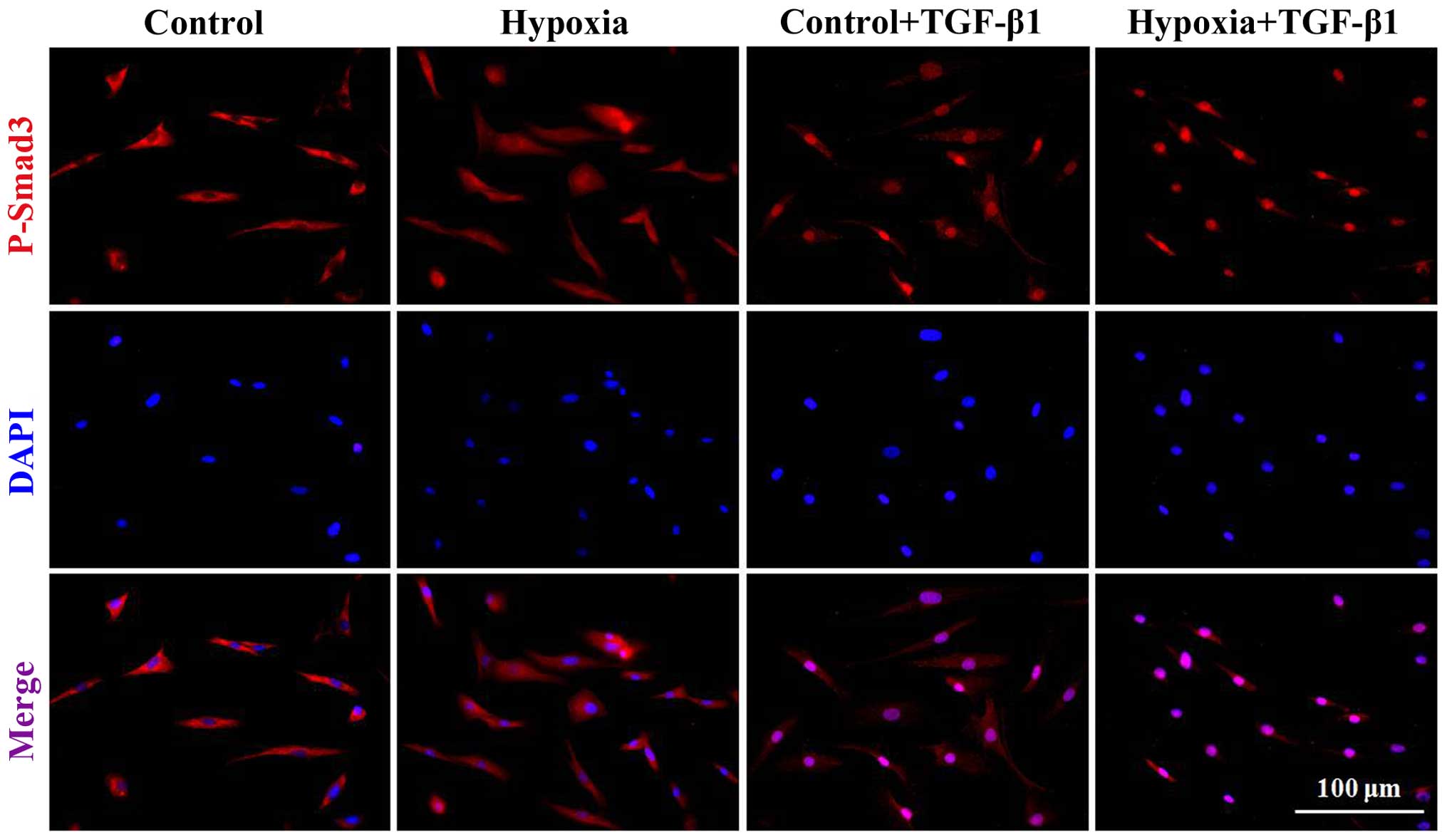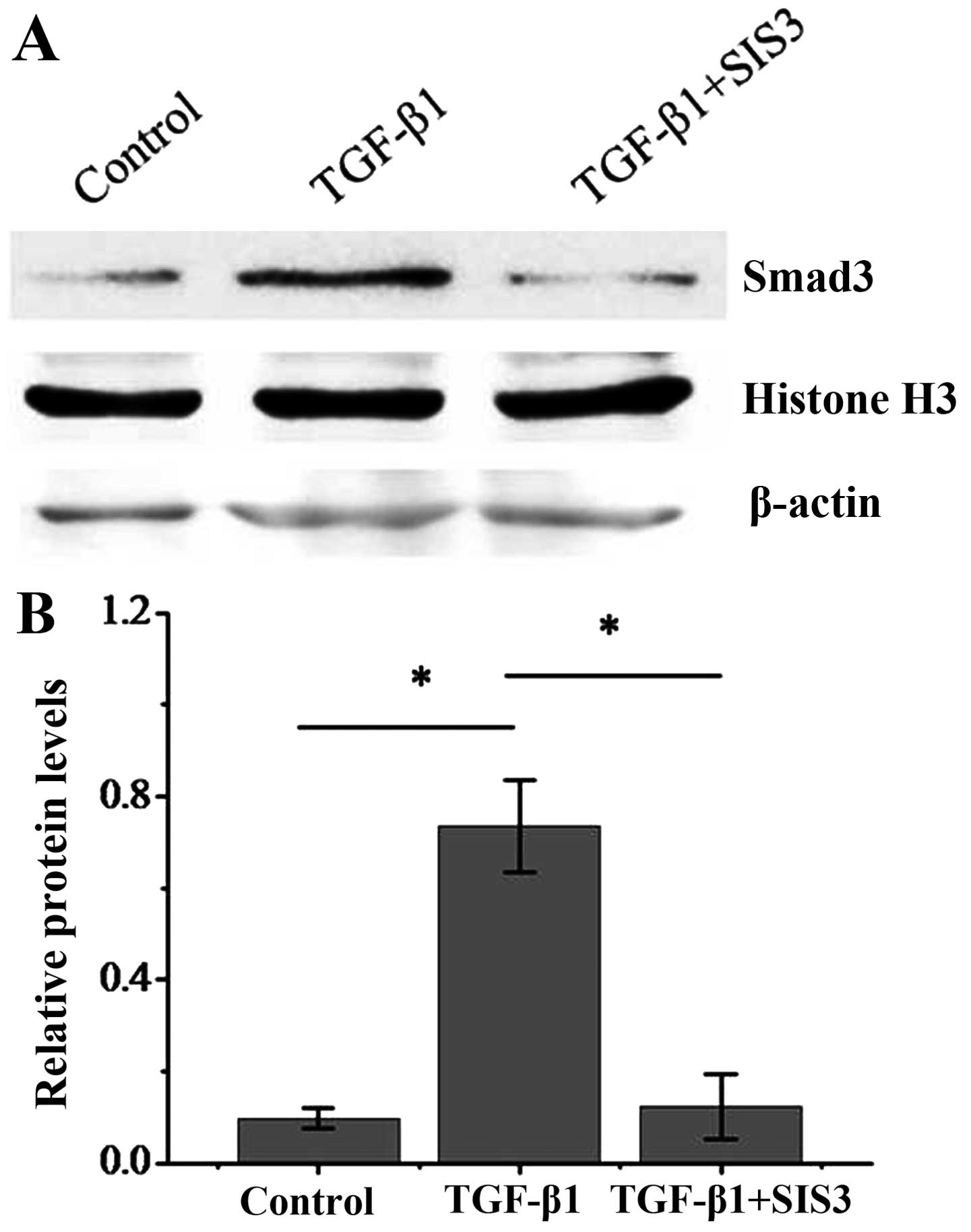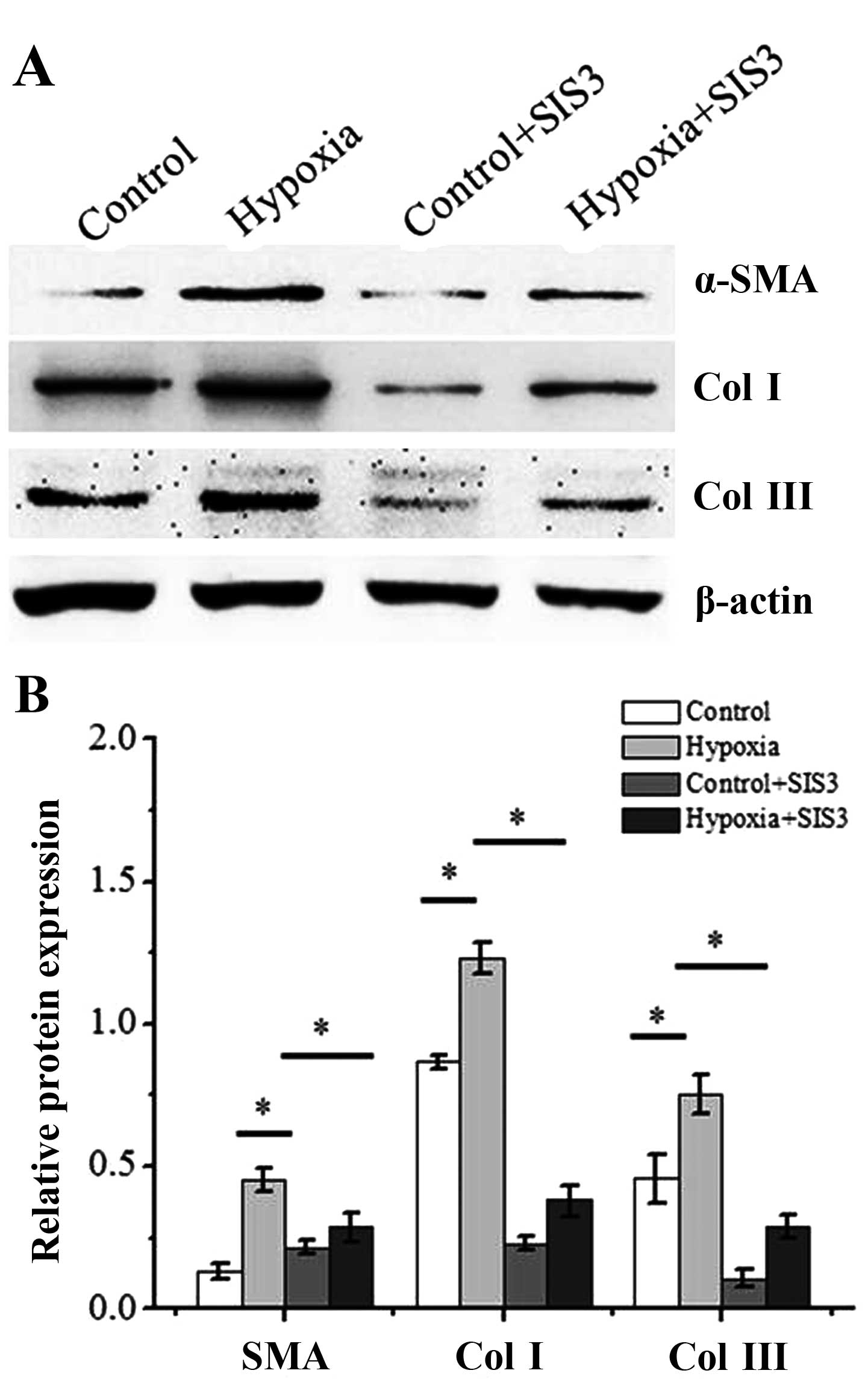Hypoxia drives the transition of human dermal fibroblasts to a myofibroblast-like phenotype via the TGF-β1/Smad3 pathway
Corrigendum in: /10.3892/ijmm.2019.4403
- Authors:
- Published online on: December 1, 2016 https://doi.org/10.3892/ijmm.2016.2816
- Pages: 153-159
-
Copyright: © Zhao et al. This is an open access article distributed under the terms of Creative Commons Attribution License.
Abstract
Introduction
Keloid scars are lesions of unknown etiology, characterized by fibroblastic proliferation and excessive collagen deposition. They develop as a result of abnormal wound healing (1). Keloid fibroblasts express α-smooth muscle actin (α-SMA) and over-secrete collagen proteins such as collagen I and III (2). The process of transition from fibroblasts to myofibroblasts is mainly regulated by transforming growth factor (TGF)-β1 (3). In response to TGF-β1, fibroblasts differentiate into myofibroblasts, which contract the wound and aid in the remodeling of the extracellular matrix (ECM) (4). The major pathway of TGF-β1-induced myofibroblast differentiation is mediated via Smad activation by the TGF-β1 receptor complex, leading to Smad2 and Smad3 complex association with Smad4 and translocation into the nucleus. Smad3 binding to Smad binding elements in the promoter region regulates α-SMA transcription in conjunction with a variety of transcription factors, to further enhance the deposition of ECM proteins (5). The imbalance of the synthesis and degradation of ECM results in scarring (6). Currently, there is no ideal treatment to reverse or reduce such dermal scarring.
Hypoxia is a common environmental stress factor and is associated with various physiological and pathological conditions, such as hepatic diseases and cancer (7,8). Hypoxia inducible factors (HIFs) are a group of transcription factors rapidly activated in hypoxic cells (9). Once activated, these transcription factors regulate the expression of genes that allow cells to adapt to a hypoxic environment. HIFs are composed of an α subunit (either HIF-1α or HIF-2α) and a β subunit (HIF-1β). HIF-1α and HIF-2α protein subunits are constitutively produced in cells (10). In normoxic cells, these subunits are immediately targeted for proteasomal degradation. In hypoxic cells however, the mechanisms that target HIFs for degradation are inhibited, allowing HIF-1α and HIF-2α to translocate to the nucleus. In the nucleus, both HIF-1α and HIF-2α heterodimerize with HIF-1β and regulate the expression of genes involved in oxygen homeostasis (11). Accumulating evidence suggests that a hypoxic microenvironment is associated with keloids due to an abnormally large number of occluded microvessels, and that hypoxia plays a crucial role in keloid pathogenesis (12,13). Hypoxia has been found to increase the expression of vascular endothelial growth factor (VEGF) in keloid fibroblasts (14). The level of HIF-1α is consistently higher in freshly biopsied keloid tissues than in their associated normal skin borders, which provides direct evidence of a local hypoxic state in keloids (9). However, whether hypoxia drives the differentiation of human dermal fibroblasts into myofibroblasts has not yet been reported, and the way this can influence human scarring is not clear. Thus, the aim of this study was to examine the effects of hypoxia on the transition of dermal fibroblasts and to clarify the potential transduction mechanisms involved.
Materials and methods
All experimental procedures were conducted under the instructions reviewed and approved by the Ethics Committee of Xijing Hospital, Xi'an, China. Keloid scar tissue and paired normal skin tissues were surgically obtained from 5 Chinese patients (male, 21 years old; male, 27 years old; male, 24 years old; male, 19 years old; male, 36 years old) with an average age of 25 years. All patients provided written informed consent prior to obtaining the samples. The diagnosis of keloid scarring was confirmed by routine pathological examination.
Cell culture and treatment
Human adult dermal fibroblasts (lot no. 61447289) were obtained from the American Type Culture Collection (ATCC, Manassas, VA, USA) and seeded at a density of 10,000 cells/cm2 in Dulbecco's modified Eagle's medium (DMEM) supplemented with 10% heat-inactivated fetal bovine serum (FBS) and 1% antibiotic-antimycotic in a humidified incubator at 37°C with 5% CO2. To induce hypoxia, the cells were placed in three-gas incubator (Thermo Fisher Scientific, Inc., Waltham, MA, USA) that maintains a sub-ambient O2 level (1%, 5% or 10%) with or without 10 ng/ml of TGF-β1 (Peprotech, Rocky Hill, NJ, USA) by the regulated injection of N2 for 48 h. The control cells were placed in a similar incubator which was maintained at 5% CO2 and 21% oxygen level. All reagents were purchased from Invitrogen (Carlsbad, CA, USA) unless otherwise stated.
Immunofluorescence staining
The cells were pre-incubated in PBS and fixed with 4% formaldehyde for 30 min, followed by incubation with rabbit anti-human p-Smad3 (9520; Cell Signaling Technology, Inc., Danvers, MA, USA) overnight at 4°C. After washing with PBS, goat anti-rabbit IgG-CFL 555 secondary antibody (sc-362272; Santa Cruz Biotechnology, Santa Cruz, CA, USA) was added in 1% BSA followed by incubation for 1 h at room temperature in the dark. Images were obtained using a FSX100 microscope (Olympus Corp., Tokyo, Japan). Nuclei were counterstained using DAPI (Sigma-Aldrich, St. Louis, MO, USA).
Cell apoptosis and viability
Flow cytometry (BD FACSAria; BD Biosciences, Franklin Lakes, NJ, USA) was performed to detect cell apoptosis. The following 2 groups were under investigation: i) the control group and ii) the 1% oxygen group. We observed the apoptotic rates at 48 h post-treatment. In accordance with the Annexin V/propidium iodide (PI) apoptosis kit (BioVision, San Francisco, CA, USA), 5×105 cells were collected in each tube and 1 ml Annexin V binding buffer was added followed by thorough mixing. Subsequently, 5 µl Annexin V-fluorescein isothiocyanate and 10 µl PI were added. After mixing, the tube was incubated in the dark at 37°C for 15 min. For the early apoptotic cells, membrane phosphatidylserine was exposed and combined with Annexin V but no PI. For the late apoptotic cells, the membranes were permeable to PI and the cells were stained with Annexin V and PI. The dead cells were stained only with PI.
Reverse transcription-quantitative polymerase chain reaction (RT-qPCR)
The TRIzol reagent kit (Invitrogen) was used for RNA extraction. The isolated RNA was reverse transcribed into complementary DNA using the PrimeScript RT Reagent kit (Takara Biotechnology Co., Ltd., Dalian, China). Primers were obtained from Beijing AuGCT DNA-SYN Biotechnology Co., Ltd., (Beijing, China). Quantitative PCR (qPCR) was performed using the iQ5 real-time PCR detection system (Bio-Rad Laboratories, Inc., Hercules, CA, USA), using SYBR Premix Ex Taq II (obtained from Takara Biotechnology Co., Ltd.) in a 20 ml volume of the PCR reaction solution. The sequences for primers are listed as follows: HIF-1α forward, 5′-AGCCGAGGAAGAACTATGAAC-3′ and reverse, 5′-ATTTGATGGGTGAGGAATGGG-3′; and GAPDH forward, 5′-GCACCGTCAAGGCTGAGAAC-3′ and reverse, 5′-TGGTGAAGACGCCAGTGGA-3′. The results were normalized against the mean Ct-values of GAPDH using the ΔCt method as follows: ΔCt = Ctgene of interest − Ctmean (GAPDH). The fold increase was calculated as 2−ΔΔCt.
Western blot analysis
Total protein lysates were generated using RIPA lysis buffer supplemented with protease and phosphatase inhibitor mixtures (KC-440; Shanghai KangChen Biological Technology Co., Shanghai, China). Nuclear protein extracts were obtained using the NE-PER nuclear and cytoplasmic extraction reagents (Pierce Biotechnology, Inc., Rockford, IL, USA), according to the manufacturer's instructions. Proteins (40 µg) were loaded onto a 5–10% polyacrylamide gel, separated by electrophoresis and transferred onto a polyvinylidene difluoride (PVDF) membrane. After blocking with 5% non-fat milk, the PVDF membrane was incubated with rabbit polyclonal antibodies to collagen I (ab96723) and III (ab7778) (both from Abcam, Cambridge, MA, USA), p-Smad2 (3108), Smad2 (3122), p-Smad3 (9520), Smad3 (9523) (all from Cell Signaling Technology, Inc.), HIF-1α (ab51608; Abcam) and histone H3 (sc-8654-R; Santa Cruz Biotechnology) or mouse polyclonal α-SMA antibody (BM0002; Wuhan Boster Biological Technology, Ltd., Wuhan, China) and β-actin antibody (4970; Cell Signaling Technology, Inc.). Horseradish peroxidase-conjugated goat anti-rabbit (BA1054) or anti-mouse (BA1050) antibody (Wuhan Boster Biological Technology, Ltd.) was used as a secondary antibody. Proteins were visualized by enhanced chemiluminescence system using FluorChem FC system (Alpha Innotech, San Leandro, CA, USA).
Statistical analysis
Statistical analyses were performed using SPSS 13.0 software (SPSS, Inc., Chicago, IL, USA). Data are presented as the means ± standard error of 3 independent experiments. Statistical analysis was performed using the Student's t-test. A value of P<0.05 was considered to indicate a statistically significant difference.
Results
Keloids are a relatively hypoxic tissue
We first determined the expression of HIF-1α in dermal normal and keloid tissue. As is known, HIF-1α functions as a key transcription factor in response to hypoxia (15). The results from western blot analysis (Fig. 1A) and RT-qPCR (Fig. 1B) demonstrated that the keloid tissue expressed higher levels of HIF-1α compared with normal tissue, which indicates that keloids are a relatively hypoxic tissue and that HIF signaling may play a role during the formation of keloids.
Hypoxia induces a pro-fibrotic state in dermal fibroblasts in vitro
Human adult dermal fibroblasts were cultured in 21, 10, 5 or 1% oxygen for 48 h. Culturing cells in 1% oxygen significantly increased the expression of HIF-1α and stabilized nuclear HIF-1α (Fig. 2). Moreover, under 1% oxygen conditions, most of the cells that were negative in staining (Q3 area) were normal. Cells in the early apoptotic phase were stained with Annexin V but no PI and are shown in the Q4 area. Cells in the late apoptotic phase were stained with Annexin V and PI, and are shown in the Q2 area, and dead cells were stained with PI and are shown in the Q1 area. The percentage of early apoptotic cells was 0.9±0.2% in the untreated group and 0.6±0.3% in the group treated with 1% oxygen. No significant differences were observed between the cells. The percentage of late apoptotic cells was 0.2±0.06% in the control group and 0.1±0.05% in the 1% oxygen-treated group. There was also no significant differences between the control group and the 1% oxygen-treated group. There was a slight trend toward more dead cells with 1% oxygen treatment, but this did not reach statistical significance (Fig. 3). The percentage of dead cells was 1.7±0.4% in the untreated group and 2.2±0.5% in the group treated with 1% oxygen (P>0.05).
We then cultured the dermal fibroblasts with 1% oxygen alone or, 10 ng/ml TGF-β1 alone or a combination of 1% oxygen and 10 ng/ml TGF-β1 for 48 h. In addition, the levels of myofibroblast makers, α-SMA and collagen I and III, were measured by western blot analysis. As shown in Fig. 4, a significant increase in both α-SMA, collagen I and III protein expression were detected at 2 days post-treatment iwth 1% oxygen compared with the controls (P<0.05). Of note, the pro-fibrotic effects of treatment with TGF-β1 were enhanced by hypoxia. Treatment of the dermal fibroblasts with TGF-β1 significantly increased the expression of α-SMA and collagen I and III (P<0.05), and this was further enhanced when the cells were exposed to hypoxia (P<0.05).
The hypoxia-induced transition of dermal fibroblasts to a myofibroblast-like phenotype is associated with the activation of Smad3
It is well known that Smad3 phosphorylation is linked to the fibrotic process (16,17). Thus, in this study, we addressed the question of whether Smad3 activation participates in the hypoxia-induced transition of dermal fibroblasts to a myofibroblast-like phenotype. First, we cultured dermal fibroblasts with 1% oxygen alone or, 10 ng/ml TGF-β1 alone, or a combination of 1% oxygen and 10 ng/ml TGF-β1 for 48 h. In addition, the phosphorylation of Smad2 and Smad3 was measured by western blot analysis (Fig. 5) and immunofluorescence staining (Fig. 6). Our results revealed that the dermal fibroblasts exposed to 1% oxygen alone or 10 ng/ml TGF-β1 alone exhibited an increase in the activity of p-Smad2 and p-Smad3. Moreover, the levels of Smad2 and Smad3 phosphorylation were further significantly enhanced when the cells were treated when a combination of TGF-β1 and 1% hypoxia (P<0.01). Immunofluorescence staining indicated that following treatment with 1% oxygen or TGF-β1 stimulation, the complex of Smad2 and Smad3 was imported from the cytoplasm to the nucleus. Furthermore, the imported complex of Smad2 and Smad3 in the nucleus was further enhanced when the cells were treated with a combination of TGF-β1 and 1% oxygen.
To further address the question of whether the Smad3 signaling pathway is required in the hypoxia-induced transition of dermal fibroblasts to a myofibroblast-like phenotype, we used the specific inhibitor of Smad3, SIS3 (18). To demonstrate that SIS3 is effective in inhibiting the activation of Smad3 through translocation to the nucleus, protein extracts from nuclear fractions was obtained from dermal fibroblasts exposed TGF-β1 with or without SIS3. The results revealed that in TGF-β1-treated dermal fibroblasts, Smad3 expression was significantly enhanced in the nucleus, suggesting nuclear translocation. However, in the TGF-β1-treated dermal fibroblasts also treated with SIS3, the expression of Smad3 was significantly impaired, indicating that SIS3 inhibited the Smad3 nuclear translocation (Fig. 7). We then examined the effects of SIS3 on the levels of fibrotic markers induced by hypoxia. SIS3 incubation inhibited the increase in the protein level of the fibrotic markers, α-SMA and collagen I and III (Fig. 8). These results suggest that the hypoxia-induced transition of dermal fibroblasts into myofibroblasts is dependent on the TGF-β1/Smad3 pathway.
Discussion
The fibroblast to myofibroblast transition is a crucial step in wound healing. Myofibroblasts contribute to tissue repair mainly by the significant enhancement of contractile and ECM synthesis (19). When the wound heals, the myofibroblasts are removed by apoptosis (20). However, the persistence of myofibroblasts in an otherwise healed wound leads to the formation of scars (21). TGF-β1 is a key fibrogenic cytokine both in vitro and in vivo. In response to TGF-β1, fibroblasts differentiate into myofibroblasts, which contract the wound and aid in the remodeling of the ECM (22). Hence, the conversion of fibroblasts into myofibroblasts by TGF-β1 is an important mechanism in the development of fibrosis (23). In addition, the regulation of cellular function by TGF-β1 is mediated by TGF-β/Smad3 signaling. Smad proteins are thought to play an important role in regulating intracellular responses to TGF-β1. Following the TGF-β1-induced phosphorylation of Smad2 and Smad3, these proteins have been shown to localize to the nucleus and form a complex with Smad4, which mediates pro-fibrotic gene expression (24).
Oxygen has long been known to play a prominent role in the healing process, re-epithelialization and other healing processes (25–27). Hypoxia has been traditionally regarded as an important stimulus for fibroblast growth and angiogenesis through the activation of HIF-1α (28). HIF-1α, which functions as a key transcription factor in response to hypoxic stress by regulating genes involved in maintaining oxygen homeostasis, is critically involved in virtually all wound healing and remodeling processes (15). It is also associated with cancer progression, metastasis and fibrotic disorders, and is emerging as an important trigger and modulator of epithelial-mesenchymal transition (EMT) (29). As has been previously reported, the epidermis is a relatively hypoxic tissue, indicating that hypoxia and HIF signaling may play a role during the formation of keloids (26,30). Our results also suggest that human keloid tissue is located in a local hypoxia environment.
It has been reported that hypoxia and HIF-1α activation can modulate EMT via the TGF-β pathway and play a key role during cancer progression and fibrotic disorders (31). It has also been demonstrated that hypoxia stimulates hepatocyte EMT by TGF-β-dependent mechanisms during the development of liver fibrosis (32). It has been indciated that hypoxia-induced epigenetic modifications are associated with cardiac fibrosis and the development of a myofibroblast-like phenotype (33). The progression of fibrosis is similar in most organs and involves pathogenic processes of interstitial hypercellularity and matrix accumulation, which lead to the loss of normal function and organ failure (34). As expected, our results revealed that hypoxia was able to drive the differentiation of normal dermal fibroblasts though an EMT-like mechanism, and are in accordance with the evidence indicated above. Moreover, the expression of p-Smad2 and p-Smad3 was significantly increased in the hypoxia-exposed cells compared with the controls, and this effect was significantly inhibited by treatment with SIS3, indicating that hypoxia is able to drive the transition of human dermal fibroblasts into myofibroblasts by regulating the TGF-β1/Smad3 pathway.
In conclusion, to the best of our knowledge, the findings of this study demonstrate for the first time that hypoxia is an important stimulus of the differentiation of human dermal fibroblasts to a myofibroblast-like phenotype. Furthermore, we demonstrate that Smad3 signaling contributes to the mechanism through which hypoxia stimulates the differentiation of fibroblasts into myofibroblasts. This information will be useful in designing new and improved therapeutic strategies against hypoxia-mediated fibrotic diseases.
Acknowledgments
This study was supported by the National Health and Family Planning Commission of China (grant no. 2015SQ00060).
References
|
Bran GM, Goessler UR, Hormann K, Riedel F and Sadick H: Keloids: current concepts of pathogenesis (Review). Int J Mol Med. 24:283–293. 2009. View Article : Google Scholar : PubMed/NCBI | |
|
Meyer LJ, Russell SB, Russell JD, Trupin JS, Egbert BM, Shuster S and Stern R: Reduced hyaluronan in keloid tissue and cultured keloid fibroblasts. J Invest Dermatol. 114:953–959. 2000. View Article : Google Scholar : PubMed/NCBI | |
|
Daian T, Ohtsuru A, Rogounovitch T, Ishihara H, Hirano A, Akiyama-Uchida Y, Saenko V, Fujii T and Yamashita S: Insulin-like growth factor-I enhances transforming growth factor-beta-induced extracellular matrix protein production through the P38/activating transcription factor-2 signaling pathway in keloid fibroblasts. J Invest Dermatol. 120:956–962. 2003. View Article : Google Scholar : PubMed/NCBI | |
|
Dong X, Mao S and Wen H: Upregulation of proinflammatory genes in skin lesions may be the cause of keloid formation (Review). Biomed Rep. 1:833–836. 2013. | |
|
Olman MA: Beyond TGF-beta: a prostaglandin promotes fibrosis. Nat Med. 15:1360–1361. 2009. View Article : Google Scholar : PubMed/NCBI | |
|
Ong CT, Khoo YT, Mukhopadhyay A, Do DV, Lim IJ, Aalami O and Phan TT: mTOR as a potential therapeutic target for treatment of keloids and excessive scars. Exp Dermatol. 16:394–404. 2007. View Article : Google Scholar : PubMed/NCBI | |
|
Zhan L, Huang C, Meng XM, Song Y, Wu XQ, Yang Y and Li J: Hypoxia-inducible factor-1alpha in hepatic fibrosis: a promising therapeutic target. Biochimie. 108:1–7. 2015. View Article : Google Scholar | |
|
O'Connell MP and Weeraratna AT: Change is in the air: the hypoxic induction of phenotype switching in melanoma. J Invest Dermatol. 133:2316–2317. 2013. View Article : Google Scholar : PubMed/NCBI | |
|
Zhang Z, Nie F, Kang C, Chen B, Qin Z, Ma J, Ma Y and Zhao X: Increased periostin expression affects the proliferation, collagen synthesis, migration and invasion of keloid fibroblasts under hypoxic conditions. Int J Mol Med. 34:253–261. 2014.PubMed/NCBI | |
|
Cash TP, Pan Y and Simon MC: Reactive oxygen species and cellular oxygen sensing. Free Radic Biol Med. 43:1219–1225. 2007. View Article : Google Scholar : PubMed/NCBI | |
|
Gaber T, Dziurla R, Tripmacher R, Burmester GR and Buttgereit F: Hypoxia inducible factor (HIF) in rheumatology: low O2! See what HIF can do! Ann Rheum Dis. 64:971–980. 2005. View Article : Google Scholar : PubMed/NCBI | |
|
Zhang Q, Wu Y, Ann DK, Messadi DV, Tuan TL, Kelly AP, Bertolami CN and Le AD: Mechanisms of hypoxic regulation of plasminogen activator inhibitor-1 gene expression in keloid fibroblasts. J Invest Dermatol. 121:1005–1012. 2003. View Article : Google Scholar | |
|
Ueda K, Yasuda Y, Furuya E and Oba S: Inadequate blood supply persists in keloids. Scand J Plast Reconstr Surg Hand Surg. 38:267–271. 2004. View Article : Google Scholar : PubMed/NCBI | |
|
Steinbrech DS, Mehrara BJ, Chau D, Rowe NM, Chin G, Lee T, Saadeh PB, Gittes GK and Longaker MT: Hypoxia upregulates VEGF production in keloid fibroblasts. Ann Plast Surg. 42:514–519; discussion 519–520. 1999. View Article : Google Scholar : PubMed/NCBI | |
|
Ruthenborg RJ, Ban JJ, Wazir A, Takeda N and Kim JW: Regulation of wound healing and fibrosis by hypoxia and hypoxia-inducible factor-1. Mol Cells. 37:637–643. 2014. View Article : Google Scholar : PubMed/NCBI | |
|
Lebrin F, Deckers M, Bertolino P and Ten Dijke P: TGF-beta receptor function in the endothelium. Cardiovasc Res. 65:599–608. 2005. View Article : Google Scholar : PubMed/NCBI | |
|
Santibañez JF, Quintanilla M and Bernabeu C: TGF-β/TGF-β receptor system and its role in physiological and pathological conditions. Clin Sci (Lond). 121:233–251. 2011. View Article : Google Scholar | |
|
Jinnin M, Ihn H and Tamaki K: Characterization of SIS3, a novel specific inhibitor of Smad3, and its effect on transforming growth factor-beta1-induced extracellular matrix expression. Mol Pharmacol. 69:597–607. 2006. View Article : Google Scholar | |
|
Liu J, Wang Y, Pan Q, Su Y, Zhang Z, Han J, Zhu X, Tang C and Hu D: Wnt/β-catenin pathway forms a negative feedback loop during TGF-β1 induced human normal skin fibroblast-to-myofibroblast transition. J Dermatol Sci. 65:38–49. 2012. View Article : Google Scholar | |
|
Tomasek JJ, Gabbiani G, Hinz B, Chaponnier C and Brown RA: Myofibroblasts and mechano-regulation of connective tissue remodelling. Nat Rev Mol Cell Biol. 3:349–363. 2002. View Article : Google Scholar : PubMed/NCBI | |
|
Desmoulière A, Chaponnier C and Gabbiani G: Tissue repair, contraction, and the myofibroblast. Wound Repair Regen. 13:7–12. 2005. View Article : Google Scholar : PubMed/NCBI | |
|
Hinz B, Celetta G, Tomasek JJ, Gabbiani G and Chaponnier C: Alpha-smooth muscle actin expression upregulates fibroblast contractile activity. Mol Biol Cell. 12:2730–2741. 2001. View Article : Google Scholar : PubMed/NCBI | |
|
Zhang Z, Nie F, Chen X, Qin Z, Kang C, Chen B, Ma J, Pan B and Ma Y: Upregulated periostin promotes angiogenesis in keloids through activation of the ERK 1/2 and focal adhesion kinase pathways, as well as the upregulated expression of VEGF and angiopoietin 1. Mol Med Rep. 11:857–864. 2015. | |
|
Jiang HS, Zhu LL, Zhang Z, Chen H, Chen Y and Dai YT: Estradiol attenuates the TGF-β1-induced conversion of primary TAFs into myofibroblasts and inhibits collagen production and myofibroblast contraction by modulating the Smad and Rho/Rock signaling pathways. Int J Mol Med. 36:801–807. 2015.PubMed/NCBI | |
|
Bosco MC, Puppo M, Blengio F, Fraone T, Cappello P, Giovarelli M and Varesio L: Monocytes and dendritic cells in a hypoxic environment: spotlights on chemotaxis and migration. Immunobiology. 213:733–749. 2008. View Article : Google Scholar : PubMed/NCBI | |
|
Sen CK and Roy S: Oxygenation state as a driver of myofibroblast differentiation and wound contraction: hypoxia impairs wound closure. J Invest Dermatol. 130:2701–2703. 2010. View Article : Google Scholar : PubMed/NCBI | |
|
Nauta TD, van Hinsbergh VW and Koolwijk P: Hypoxic signaling during tissue repair and regenerative medicine. Int J Mol Sci. 15:19791–19815. 2014. View Article : Google Scholar : PubMed/NCBI | |
|
Kelly BD, Hackett SF, Hirota K, Oshima Y, Cai Z, Berg-Dixon S, Rowan A, Yan Z, Campochiaro PA and Semenza GL: Cell type-specific regulation of angiogenic growth factor gene expression and induction of angiogenesis in nonischemic tissue by a constitutively active form of hypoxia-inducible factor 1. Circ Res. 93:1074–1081. 2003. View Article : Google Scholar : PubMed/NCBI | |
|
Haase VH: Oxygen regulates epithelial-to-mesenchymal transition: insights into molecular mechanisms and relevance to disease. Kidney Int. 76:492–499. 2009. View Article : Google Scholar : PubMed/NCBI | |
|
Sloan DF, Brown RD, Wells CH and Hilton JG: Tissue gases in human hypertrophic burn scars. Plast Reconstr Surg. 61:431–436. 1978. View Article : Google Scholar : PubMed/NCBI | |
|
Zavadil J and Böttinger EP: TGF-beta and epithelial-to-mesenchymal transitions. Oncogene. 24:5764–5774. 2005. View Article : Google Scholar : PubMed/NCBI | |
|
Copple BL: Hypoxia stimulates hepatocyte epithelial to mesenchymal transition by hypoxia-inducible factor and transforming growth factor-beta-dependent mechanisms. Liver Int. 30:669–682. 2010. View Article : Google Scholar : PubMed/NCBI | |
|
Watson CJ, Collier P, Tea I, Neary R, Watson JA, Robinson C, Phelan D, Ledwidge MT, McDonald KM, McCann A, et al: Hypoxia-induced epigenetic modifications are associated with cardiac tissue fibrosis and the development of a myofibroblast-like phenotype. Hum Mol Genet. 23:2176–2188. 2014. View Article : Google Scholar | |
|
Henderson NC, Arnold TD, Katamura Y, Giacomini MM, Rodriguez JD, McCarty JH, Pellicoro A, Raschperger E, Betsholtz C, Ruminski PG, et al: Targeting of αv integrin identifies a core molecular pathway that regulates fibrosis in several organs. Nat Med. 19:1617–1624. 2013. View Article : Google Scholar : PubMed/NCBI |



